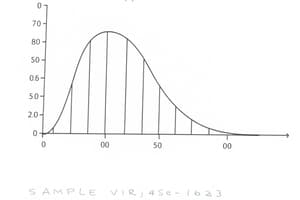Podcast
Questions and Answers
Why can the range be considered a misleading measure of dispersion?
Why can the range be considered a misleading measure of dispersion?
- It is not affected by extreme values in the data.
- It provides a thorough summary of the central tendency.
- It considers the distribution of all values equally.
- It ignores the distribution and is sensitive to outliers. (correct)
What does a variance of zero indicate about the observations in a data set?
What does a variance of zero indicate about the observations in a data set?
- The observations vary greatly and are inconsistent.
- The observations are concentrated at the same value. (correct)
- The observations fluctuate significantly around the mean.
- The observations are widely spread from the mean.
Given the data set 1, 1, 1, 1, 1, 1, 1, 1, 1, 1, 1, 2, 2, 2, 2, 2, 2, 2, 2, 3, 3, 3, 3, 4, 5, what is the range?
Given the data set 1, 1, 1, 1, 1, 1, 1, 1, 1, 1, 1, 2, 2, 2, 2, 2, 2, 2, 2, 3, 3, 3, 3, 4, 5, what is the range?
- 3
- 5
- 2
- 4 (correct)
How does the variance behave in relation to the mean?
How does the variance behave in relation to the mean?
Which of the following data sets would likely yield a larger variance?
Which of the following data sets would likely yield a larger variance?
What does the sample variance represent in a dataset?
What does the sample variance represent in a dataset?
Which of the following is true about the value of sample variance, $S^2$?
Which of the following is true about the value of sample variance, $S^2$?
When would the sample variance, $S^2$, equal zero?
When would the sample variance, $S^2$, equal zero?
If you increase the sample size while keeping values constant, what will happen to the sample variance?
If you increase the sample size while keeping values constant, what will happen to the sample variance?
How is the sample variance calculated from the squared deviations?
How is the sample variance calculated from the squared deviations?
Flashcards are hidden until you start studying
Study Notes
Range
- The range is the simplest measure of dispersion.
- It is calculated by finding the difference between the largest and smallest values in a data set.
- Formula: Range = Largest Value - Smallest Value
Why the Range Can Be Misleading
- The range is sensitive to outliers, which can lead to misleading results.
- The range does not consider how the data is distributed.
Variance
- The variance is a key measure of dispersion.
- It uses the mean as a reference point.
- A smaller variance indicates observations are closer to the mean.
- A larger variance indicates observations are more spread out from the mean.
- A variance of zero means all observations are equal (and equal to the mean).
- The sample variance is used to approximate the population variance.
Formula for Sample Variance
- $S^2 = \frac{\sum_{i=1}^{n}(x_i - \bar{x})^2}{n-1}$
Where:
- $\bar{x}$: arithmetic mean
- n: sample size
- $x_i$: ith value of the variable X
Notes:
- $S^2$ is a statistic as it is calculated from sample values.
- $S^2$ is always greater than or equal to 0.
Standard Deviation
- The standard deviation is a commonly used measure of how much data values are spread out around the mean.
- It is the square root of the variance.
- It is expressed in the same units as the original data.
- This means it shows the typical distance between a data point and the mean for the dataset.
Formula for Standard Deviation
- $s = \sqrt{\frac{\sum(x - \bar{x})^2}{n-1}}$
Studying That Suits You
Use AI to generate personalized quizzes and flashcards to suit your learning preferences.




